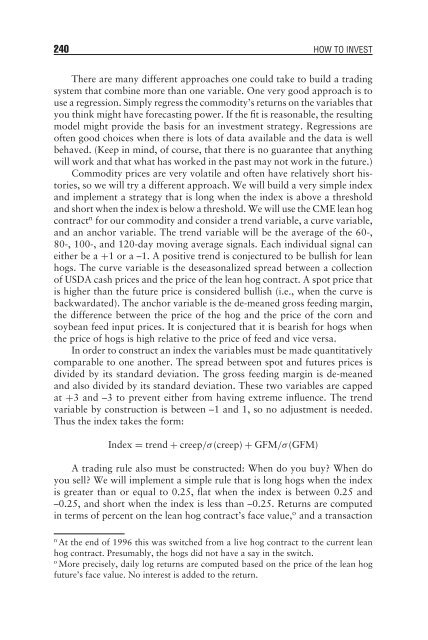Maximizing Returns through Fundamental Analysis - Arabictrader.com
Maximizing Returns through Fundamental Analysis - Arabictrader.com
Maximizing Returns through Fundamental Analysis - Arabictrader.com
Create successful ePaper yourself
Turn your PDF publications into a flip-book with our unique Google optimized e-Paper software.
240 HOW TO INVEST<br />
There are many different approaches one could take to build a trading<br />
system that <strong>com</strong>bine more than one variable. One very good approach is to<br />
use a regression. Simply regress the <strong>com</strong>modity’s returns on the variables that<br />
you think might have forecasting power. If the fit is reasonable, the resulting<br />
model might provide the basis for an investment strategy. Regressions are<br />
often good choices when there is lots of data available and the data is well<br />
behaved. (Keep in mind, of course, that there is no guarantee that anything<br />
will work and that what has worked in the past may not work in the future.)<br />
Commodity prices are very volatile and often have relatively short histories,<br />
so we will try a different approach. We will build a very simple index<br />
and implement a strategy that is long when the index is above a threshold<br />
and short when the index is below a threshold. We will use the CME lean hog<br />
contract n for our <strong>com</strong>modity and consider a trend variable, a curve variable,<br />
and an anchor variable. The trend variable will be the average of the 60-,<br />
80-, 100-, and 120-day moving average signals. Each individual signal can<br />
either be a +1 or a –1. A positive trend is conjectured to be bullish for lean<br />
hogs. The curve variable is the deseasonalized spread between a collection<br />
of USDA cash prices and the price of the lean hog contract. A spot price that<br />
is higher than the future price is considered bullish (i.e., when the curve is<br />
backwardated). The anchor variable is the de-meaned gross feeding margin,<br />
the difference between the price of the hog and the price of the corn and<br />
soybean feed input prices. It is conjectured that it is bearish for hogs when<br />
the price of hogs is high relative to the price of feed and vice versa.<br />
In order to construct an index the variables must be made quantitatively<br />
<strong>com</strong>parable to one another. The spread between spot and futures prices is<br />
divided by its standard deviation. The gross feeding margin is de-meaned<br />
and also divided by its standard deviation. These two variables are capped<br />
at +3 and –3 to prevent either from having extreme influence. The trend<br />
variable by construction is between –1 and 1, so no adjustment is needed.<br />
Thus the index takes the form:<br />
Index = trend + creep/σ (creep) + GFM/σ (GFM)<br />
A trading rule also must be constructed: When do you buy When do<br />
you sell We will implement a simple rule that is long hogs when the index<br />
is greater than or equal to 0.25, flat when the index is between 0.25 and<br />
–0.25, and short when the index is less than –0.25. <strong>Returns</strong> are <strong>com</strong>puted<br />
in terms of percent on the lean hog contract’s face value, o and a transaction<br />
n At the end of 1996 this was switched from a live hog contract to the current lean<br />
hog contract. Presumably, the hogs did not have a say in the switch.<br />
o More precisely, daily log returns are <strong>com</strong>puted based on the price of the lean hog<br />
future’s face value. No interest is added to the return.










